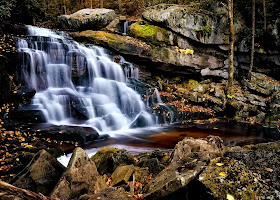The lovely Elakala Falls are a
series of four waterfalls of Shays Run as it descends into the Blackwater
Canyon in West Virginia. They’re within Blackwater Falls State Park and are reasonably
popular among photographers, with the ease of access for the first waterfall,
and the relatively low traffic of the other waterfalls in the series. The first
of the series of waterfalls is 35 feet in height and is very easily accessible
from park trails, which is second most popular waterfall in the park. From
Elakala trail there is a bridge over the top of the first waterfall offering
easy access and views. The remaining three waterfalls of the series are
progressively more difficult to access, and have no official marked trails to
them. The gorge is nearly 200 feet deep at this section accounting for the
difficulty of the descent to the lower waterfalls of the series.
The second waterfall is only 15
feet tall and is the smallest in the series, however remains popular by the
well-worn path from the first falls. The third waterfall of the series is the
highest at 40 feet tall but it is particularly difficult to reach. It has a
path worn to it but is very steep and rocky terrain. Traveling beyond the
second waterfall should be considered for experienced hikers only due to the
danger of descending the canyon without trails. The fourth and final waterfall
of the series is considered quite dangerous to access, with no trails, and
should not be attempted by inexperienced hikers.
This attractive waterfall is
accessed by a short trail starting out from the park’s main lodge. The
falls are less than a quarter mile down the trail. The trail truly
doesn’t give you a good look at the waterfall, so take the time to follow the unofficial
foot path down the ravine to the base of the falls. Elakala is loveliest
in times of heavy water flow. The water stream leaving the base of the
falls takes a lovely swirling path across the moss-greened rocks. But
make sure don’t miss climbing a little farther down the ravine to view a couple
other pretty waterfalls on Shays Run. The stream actually cascades all
the way down to the bottom of the Blackwater Canyon, but it’s not actually safe
to go much beyond the second or third cascade. In winter the Elakala falls
completely frozen over, and the sound of the water running under the ice was
magical.
The name of the waterfalls comes
from a Native American legend, although numerous meaningfully different
versions exist. According to some sources it involves a princess which name was
Elakala who threw herself over the edge of the first waterfall when her lover despised
her. But another source said the legend involves a Massawomee warrior named
Elakala who was shy-girl and fell to his death from the falls while being chased
by two women of his tribe. Alike legends exist for numerous waterfalls in the
eastern United States, and there is of course no way to confirm these stories.


































